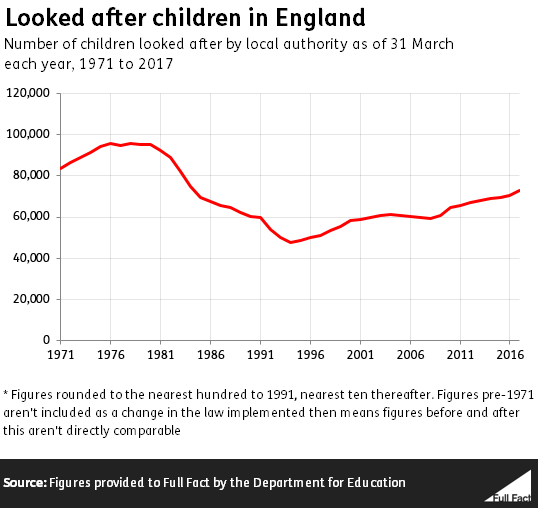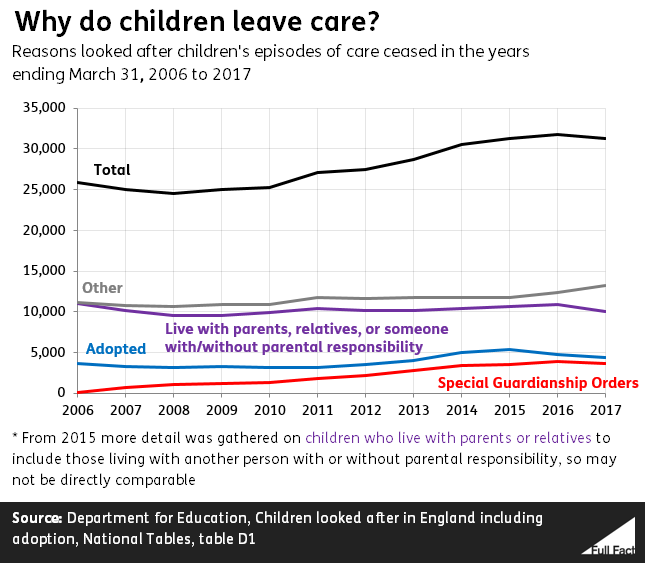What Children Are Being Taken From Their Families
"The state is removing more children from their families than at any fourth dimension since the 1980s"
The Economist, 22 March 2018
Nosotros don't know exactly how many children are separated from their parents in England, but it's articulate from available figures that this is likely to be happening to record numbers since the 1980s.
To become an idea how many children are beingness separated, we demand to consider how many children are condign 'looked later' by a local authority, and so what happens to them afterwards. Some will return home, while others will be adopted or placed with a guardian.
Neither prepare of figures gives us the full picture: not all children who are in the care of a local authorization are actually away from their parents, and not all children who've been adopted or placed with another guardian will remain in that situation, as some placements tin can fall through.
In spite of those drawbacks, they still evidence a articulate trend of increasing numbers of children entering the care organisation, in the care system and existence placed with new families.
Increasing numbers of children are existence looked after by a local authority
The number of children being "looked later" by their local say-so in England is at its highest point since 1984. Published figures we plant only become back to 1994, but the Department for Education showed us figures going back to 1966.
There were almost 72,700 children beingness looked afterward in England in the yr ending March 2017. The final time the number was that loftier was in the twelvemonth catastrophe March 1984 when there were 74,800. In 1985 this dropped to 69,600 looked later on children.
Dorsum in 2015, the Department for Education said: "The number of looked after children [in England] has increased steadily over the by 7 years and it is now higher than at whatsoever point since 1985."
These figures tell united states of america how many children are in the care organization at whatsoever one time, but to get a sense of how many are being 'removed', we demand to look at how many are entering the care organisation.
The number of children who started existence looked after in 2017 has also been increasing in contempo years, later on falling in the early 2000s. There were around 32,800 children who started to exist looked subsequently in the yr to March 2017. That's slightly college at present than it was in 1994.
We tin also take into account population changes when looking at the increase in the number of children being looked after. In 2013 there were sixty children per 10,000 under the age of 18 being looked afterwards, this stayed the same until 2017 when it increased to 62.
'Looked after' tin can mean a variety of things
The definition of being "looked after" is wider than it might sound. Looked after children tin include those who are fostered, placed in secure units, children's homes, or live independently. They can be placed for adoption also, and some are placed with their parents, only with extra supervision from social services.
So being under the care of the local authorisation doesn't necessarily mean the child has been removed from their parents. vi% of children beingness looked after at the cease of March 2017 were placed with their parents—that'due south around iv,370 children. The proportion of children beingness placed with their parents has stayed roughly the aforementioned for at least the last v years.
Effectually three-quarters of children being looked later on were in a foster placement in the year ending March 2017. Existence fostered can too include placements with relatives or family friends.
In about cases the primary reason given for a kid being looked subsequently by a local authority was abuse or neglect. This was the reason for around 60% of children being looked after by their local council at the end of March each year between 2013 and 2017.
Increasing numbers of children are existence adopted or placed with a guardian
Children besides exit the care system for a multifariousness of reasons.
The number of children who've been adopted or placed with a special guardian is probable to be growing, and increasing numbers each year are beingness placed in this way.
In the year ending March 2017, 4,350 looked after children were adopted, which was effectually xiv% of all children who ceased being looked after (effectually 31,300). Effectually iii,700, or eleven%, were subject to a Special Guardianship Order (SGO).
SGOs appoint ane or more than people who aren't the child's parents to become their special guardian. They are legally secure placements which are meant to exist permanent, giving guardians parental responsibility simply not severing ties betwixt the child and their birth parents in the mode adoption can. They came into force late in 2005.
If you lot add together together the number of looked after children who stopped being looked subsequently considering they were adopted or subjected to an SGO, the figure has more doubled in roughly the last decade. It went from 3,800 in 2006 to 8,000 in 2017, thanks to an increase in SGOs.
Analysis from Community Intendance shows the numbers being placed on adoption or special guardianship combined much higher in recent years than in the 1990s.
Other children get out the intendance organization and return home
The biggest single reason children leave the care arrangement is to return abode to live with parents, relatives, or some other person with or without parental responsibility. This accounted for nigh a tertiary of leavers.

17% of children who stopped being looked afterward in 2017 did so for "any other reason". According to the Department of Education the majority in that category left care on their xviiithursday birthday. Other reasons for leaving care included moving into independent living with supportive accommodation or being subject to resident or kid arrangement orders.
Children in foster placements count as being looked after by the local authority, so are non included here.
What's behind the increase in looked after children?
Several possible factors that could have contributed to the increase take been proposed.
A local authorisation might apply for a care gild from a court if at that place are concerns about a child's welfare. An officeholder from the Children and Family Courtroom Advisory and Support Service (Cafcass) represents children in family court proceedings.
The tragic death in 2007 of 17 calendar month-old Peter Connelly, known equally Babe P, made headlines a year afterwards afterwards his mother, her boyfriend, and his brother were institute to accept caused or allowed his death.
The twelvemonth after Baby P's death, a Serious Instance Review into what happened was published. Cafcass establish that in the straight backwash of this review, care applications over the post-obit xx days went up 37% compared to the proceeding 20 days, and were 23% higher than the aforementioned menstruation a year before.
In 2012 a committee of MPs said this was likely to be the single most important factor behind the increase in the number of children existence looked afterward since and so. But it too said that there had already been an increase since July of that twelvemonth, earlier the Serious Case Review was published.
It besides said the increase may have been down to new guidance issued in 2010 that meant local regime as well had to beginning providing accommodation to sixteen and 17 year-olds who are homeless or require accommodation.
Co-ordinate to figures provided to usa by Cafcass, the number of care applications more than doubled between in the decade up to 2016/17.
Source: https://fullfact.org/education/are-more-children-being-taken-from-their-families/
0 Response to "What Children Are Being Taken From Their Families"
Post a Comment